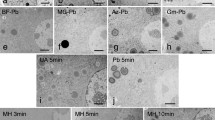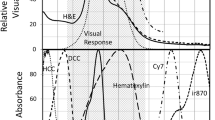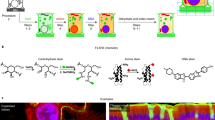Abstract
THE standard Schiff reagent (basic fuchsin plus sulphurous acid) has been used widely in cytochemistry to localize such aldehyde moieties as deoxyribonucleic acid by the Feulgen reaction and 1, 2 glycols (polysaccharides) by the periodic acid-Schiff reaction. Work in this laboratory designed to provide other reliable aldehyde-specific reagents (Schiff-type reagents) has been completed1,2.
This is a preview of subscription content, access via your institution
Access options
Subscribe to this journal
Receive 51 print issues and online access
$199.00 per year
only $3.90 per issue
Buy this article
- Purchase on Springer Link
- Instant access to full article PDF
Prices may be subject to local taxes which are calculated during checkout
Similar content being viewed by others
References
Kasten, F. H., Stain Tech., 33, 39 (1958).
Kasten, F. H., Histochemie (submitted for publication).
Ornstein, L., Mautner, W., Davis, B. J., and Tamura, R., J. Mount Sinai Hosp., 24, 1066 (1957).
Hotchkiss, R. D., Arch. Biochem., 16, 131 (1948).
von Bertalanffy, L., Masin, F., and Masin, M., Science, 124, 1024 (1956).
von Bertalanffy, L., Masin, F., and Masin, M., Cancer, 11, 873 (1958).
Author information
Authors and Affiliations
Rights and permissions
About this article
Cite this article
KASTEN, F., BURTON, V. & GLOVER, P. Fluorescent Schiff-Type Reagents for Cytochemical Detection of Polyaldehyde Moieties in Sections and Smears. Nature 184, 1797–1798 (1959). https://doi.org/10.1038/1841797a0
Issue Date:
DOI: https://doi.org/10.1038/1841797a0
This article is cited by
-
Fluorescent labeling of abundant reactive entities (FLARE) for cleared-tissue and super-resolution microscopy
Nature Protocols (2022)
-
Proze�gesteuerte Aufzeichnung der spektralen Absorptionskurven mikroskopischer Objekte (Pasamo)
Histochemistry (1974)
-
Über den Mechanismus einiger „Schiff-Typ“-Reaktionen zum DNS-Nachweis und deren cytophotometrische Auswertung
Histochemie (1972)
-
Einflu� der Fixierung und der S�urekonzentration auf die Feulgen-Hydrolyse bei 28� C
Histochemie (1968)
-
Fluorescence cytophotometry: a valuable method for the quantitative determination of nuclear feulgen-DNA
Histochemie (1968)
Comments
By submitting a comment you agree to abide by our Terms and Community Guidelines. If you find something abusive or that does not comply with our terms or guidelines please flag it as inappropriate.



